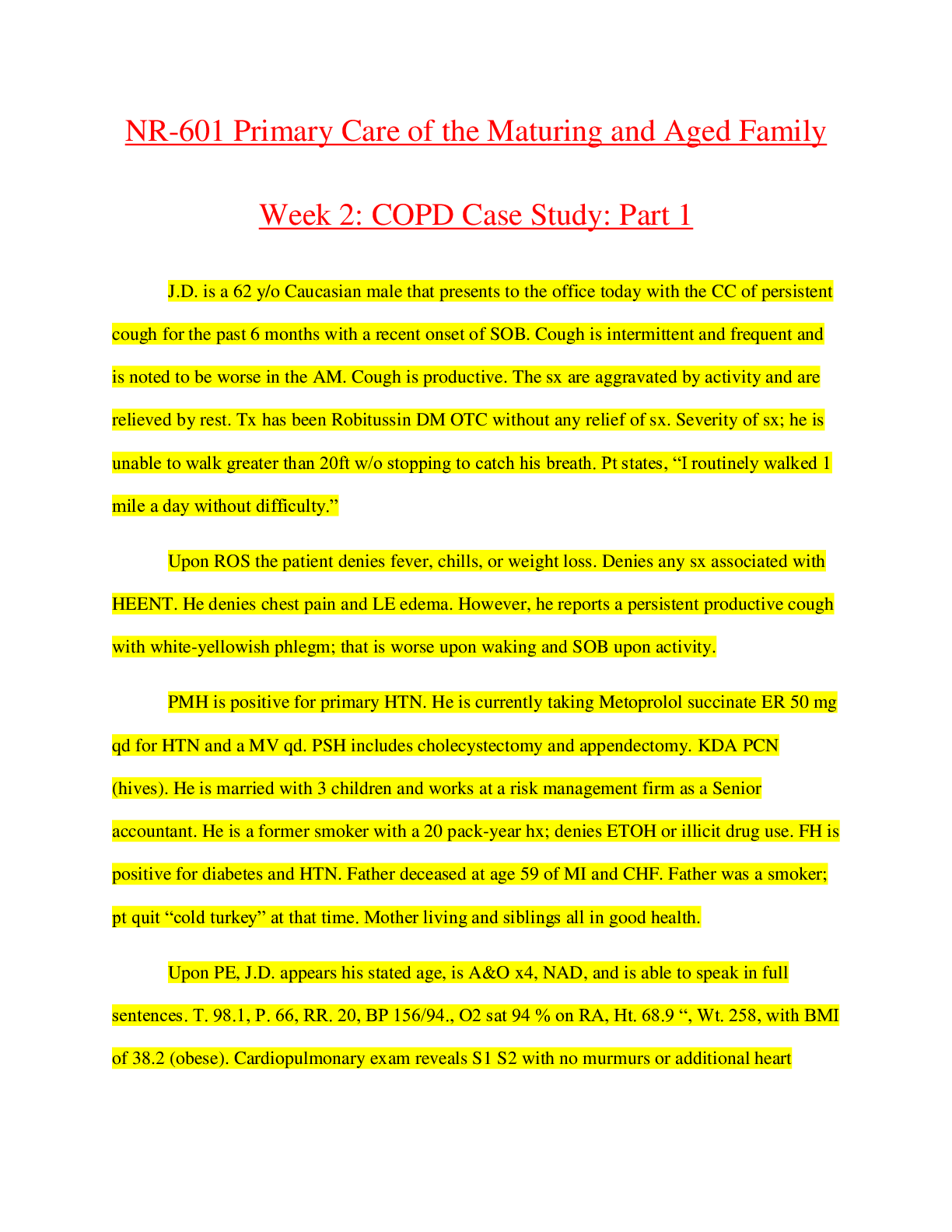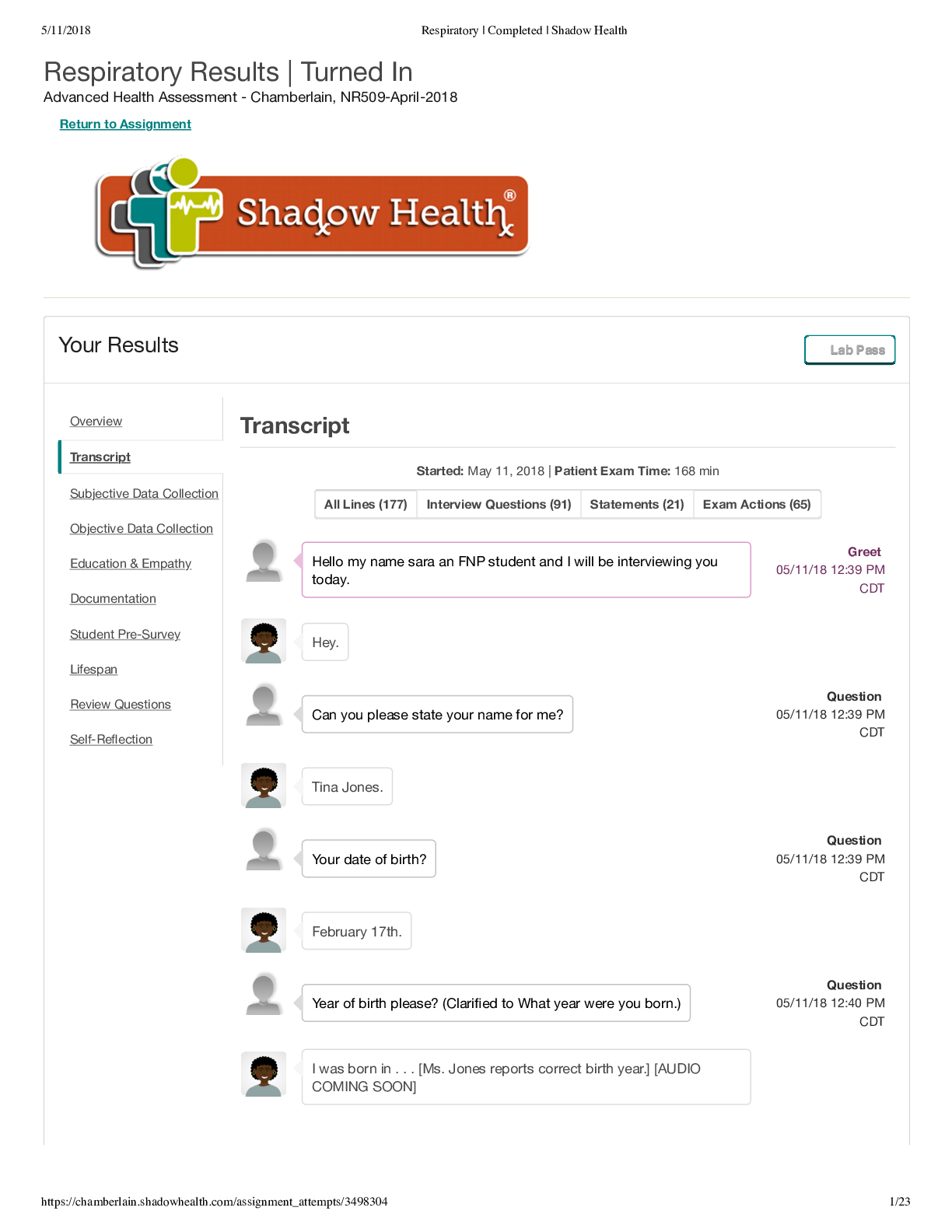Health Care > CASE STUDY > Case Study by Emily Walker, Chamberlain College of Nursing, NR601: Primary Care of the Maturing and (All)
Case Study by Emily Walker, Chamberlain College of Nursing, NR601: Primary Care of the Maturing and Aged Family, Primary Diagnosis: Type 2 diabetes mellitus without complications (E11.9)
Document Content and Description Below
Case Study Emily Walker Chamberlain College of Nursing NR601: Primary Care of the Maturing and Aged Family In this case study, Mrs. W is a 59-year old Asian female who reports to the clinic f... or a three-month follow-up of right knee arthritis. She has new complaints today, such as fatigue for the past 3 months and steady weight gain since menopause 4 years ago. The patient exercises twice a week by walking 30 minutes on a treadmill and light lifting to lose weight but has gained 4lbs since last visit. The student will review the patient’s subjective and objective findings of the examination. The purpose of this paper is to assess the primary, secondary, and differential diagnoses for this patient, as well as formulate a management-based plan utilizing evidence- based guideline which includes diagnostics, medications, education, referrals, and follow-up care. This paper will discuss costs of medications including prescribed and over-the-counter (OTC). Assessment Mrs. W is a 59-year old Asian female for follow-up of right knee arthritis and complaints of fatigue, weight gain, increase in hunger and thirst, and frequent urination during the day and night. Vital signs were stable, but the patient is obese with a body mass index (BMI) of 30.7. The physical exam was normal except it is note that the patient wears contacts. Fasting morning labs were drawn. Labs within normal limits including the white blood count, hemoglobin and hematocrit, liver and kidney function, and thyroid levels. The abnormal labs comprised of fasting plasma glucose, hemoglobin A1C, and lipid panel. The patient’s urinalysis was normal except for 1+ glucose. Primary Diagnosis Type 2 diabetes mellitus without complications (E11.9) Pathophysiology. Type 2 diabetes is associated with insulin secretory insufficiency. The pathophysiology is related to b-cell dysfunction because of inflammation and metabolic stress in association with genetic factors. Common signs and symptoms of type 2 diabetes are increased thirst, excessive hunger, frequent urination, fatigue, weight gain or weight loss (American Diabetes Association (ADA), 2018). Pertinent positive findings. According to the ADA (2018), a fasting plasma glucose (FPG) greater than or equal to 126 or an A1C greater than or equal to 6.5% are two different criteria utilized to diagnose diabetes. The patient in this case study had a FPG of 130 and a A1C of 6.8% meaning that she has a new diagnosis of diabetes. Pertinent negative findings. Mrs. W doesn’t have a family history of diabetes and exercises twice a week with 30 minutes of walking on a treadmill and light weight lifting. Diabetes is usually associated with a sedentary lifestyle; however, Mrs. W seems to have only started exercising three months ago when she was diagnosed with arthritis of her right knee. Rationale for the diagnosis. Mrs. W has a 12-week history of fatigue, weight gain of 4lbs, and an increase in hunger, thirst, and urination. All of these symptoms are congruent with type 2 diabetes. The FPG of 130, A1C of 6.8%, and BMI of 30.7 (height 5’1.5’’ and weight 165lbs). According to the ADA (2018), a FPG greater than or equal to 126 mg/dL and a A1C greater than or equal to 6.5% deems the patient as a diabetic. The patient is classified as obese with a BMI of 30.7 and it is warranted to screen patients of the Asian American race for type 2 diabetes if he or she has a BMI greater than or equal to 23 (ADA, 2018). Secondary Diagnosis Mixed hyperlipidemia (E78.2) Pathophysiology. Hyperlipidemia is a term given to elevated concentrations of lipids in the plasma. This metabolic disorder is characterized by levels of lipids and lipoproteins in the plasma that increase the risk for atherosclerotic disease. Patients oftentimes present without any symptoms of hyperlipidemia, but a physical exam may reveal a carotid bruit, xanthomas, or corneal arcus (Dunphy, Winland-Brown, Porter, & Thomas, 2015). Pertinent positive findings. The patient’s lipid panel concluded a total cholesterol of 215 mg/dL, LDL 144 mg/dl; VLDL 36 mg/dl; HDL 32mg/dl, and triglycerides 229. The patient’s LDL is 144 mg/dL which is classified as high as the goal is to have the level less than 100 and the patient’s triglycerides are 229 which is high as the goal is to have the level less than 150 (Jellinger et al., 2017). The patient is diagnosed with diabetes which is a common secondary cause for dyslipidemia (Jellinger et al., 2017). Pertinent negative findings. The patient’s blood pressure is well-controlled, no known history of cardiac disease, and no known family history of cardiac disease. Jellinger et al. (2017) utilizes the patient’s past medical history, past family history, and age when addressing screening parameters for hyperlipidemia; the patient’s age was the only known reason for her to be screened. Rationale for the diagnosis. Mixed hyperlipidemia doesn’t have any warning signs unless associated with a cardiac event. Therefore, screening guidelines are in place to not miss a diagnosis. According to Jellinger et al. (2017), individuals should be screened in the absence of cardiovascular disease if the person is a male and between ages 46- 65 or in a woman aged 55-65 years old. This patient prior to drawing the labs was not known to have diabetes, but she is 59 years-old and needed to be screened. The labs from today are also consistent with the diagnosis of mixed hyperlipidemia with an elevated LDL of 144 mg/dL and triglycerides of 229 which are both categorized as high according to the American Association of Clinical Endocrinologists 2017 guidelines. Secondary Diagnosis Obesity, unspecified (E66.9) Pathophysiology. Obesity is derived from complex and interrelated metabolic factors. Adipocytes are endocrine cells that have many roles in the body, including regulation of metabolism, energy intake, and fat storage. Genetics plays a role in obesity as adiposity is highly inheritable (Cefalu et al., 2015). Pertinent positive findings. A BMI of greater than or equal to 30 is indicative of obesity (Cefalu et al., 2015). The patient in this study is 5’ 1.5’’ tall and weighs 15lbs which means she has a BMI of 30.7 and is obese. Pertinent negative findings. A normal BMI is 18.5-24.9, overweight is a BMI of 25- 29.9, and obese is a BMI of greater than or equal to 30 (Cefalu et al., 2015). Mrs. W will need to lose 31lbs to be at a normal weight per her BMI. Rationale for the diagnosis. Approximately two-thirds of the American population are overweight or obese (Cefalu et al., 2015). An increase in obesity rates has shown an increase in risk of type 2 diabetes, cardiovascular disease, hypertension, arthritis, cognitive impairment, and some cancers (Cefalu et al., 2015). This patient has a BMI of 30.7 and is classified as obese. Secondary Diagnosis Unilateral primary osteoarthritis, right knee (M17.11) Pathophysiology. Osteoarthritis occurs when there is a dysregulation of breakdown and repair of cartilage in any joint (Brown, 2013). Risk factors for osteoarthritis include trauma, overuse, and genetic predisposition. Common signs and symptoms of osteoarthritis are joint pain, stiffness, and decreased mobility (Brown, 2013). Pertinent negative findings. A family history of osteoarthritis, prior joint trauma, and repetitive activities were not noted in the case study (Shelton, 2013). Repetitive motions increase the risk for osteoarthritis, but this patient works from home and it is unlikely that she is very ambulatory with her job as an administrative assistant. Pertinent positive findings. According to Brown (2013), prevalence of osteoarthritis increases with age, women are at a greater risk especially after menopause, and obesity. Mrs. W is over the age of 50, went through menopause four years ago, and is obese with a BMI of 30.7. She was prescribed Tylenol 500mg two tablets daily and stated an improvement in right knee pain and mobility since starting treatment 3 months ago. Rationale for the diagnosis. The patient doesn’t denote signs and symptoms of the right knee pain in the case study except that pain was decreased and mobility was increased after acetaminophen use in the morning for the past 3 months (Brown, 2013). A common tale-tell sign of osteoarthritis is stiffness in the morning that improves after 30 minutes. Osteoarthritis may occur in only one joint, such as the knee (Brown, 2013). Differential Diagnosis Vitamin D deficiency, unspecified (E55.9) Pathophysiology. Vitamin D occurs naturally and is a hormone that exists in two forms: vitamin D (ergocalciferol) and vitamin D (cholecalciferol) (Rose, 2013). The forms are converted in the liver, whereas one form turns into caicidiol for storage and the other form goes to the kidneys and turns into the active form called calcitriol (Rose, 2013). Pertinent positive findings. Vitamin D deficiency is more common in darker skin pigmented individuals and obesity (LeFevre, 2015). This patient is Asian and is classified as obese with a BMI of 30.7. Pertinent negative findings. Vitamin D deficiency is usually associated with increased risk for fractures and screening is performed in patients with osteoporosis or for fall prevention (LeFevre, 2015). It is not noted in this case study that the patient has had a history of fractures or falls. Rationale for the diagnosis. The student chose this differential diagnosis related to the patient’s obesity, probable decrease in sun exposure related to working from home, and complaint of fatigue over the past 3 months (LeFevre, 2015). To asses for this diagnosis, a total serum 25-vitaminhydroxy (OH) D will need to be drawn. Vitamin D deficiency is defined as a total serum 25-(OH) D level of less than 50 nmol/L and vitamin D insufficiency as 52.5 to 72.5 nmol/L and recommends treatment of persons with a vitamin D deficiency (LeFevre, 2015). Plan Diagnostics Lab test for diabetes. Mrs. W’s FPG was 130 and her A1C was 6.8%. According to ADA (2018), if two different tests, such as the FPG and A1C, are above the diagnostic threshold then a confirmatory diagnosis of diabetes has been made. It is then confirmed that Mrs. W is now diagnosed with diabetes as the threshold for a FPG is greater than or equal to 126 and the threshold for A1C is greater than or equal to 6.5% (ADA, 2018). A repeat FPG and A1C should be performed 3 months after the initiation of medication (ADA, 2018). Lab test for vitamin D deficiency. A differential diagnosis of vitamin D deficiency was noted. In order to diagnose or rule out this differential, additional lab will need to be drawn. A total serum 25-OH D will assist the provider in diagnosing a vitamin D insufficiency, deficiency, or normal result (LeFevre, 2015). [Show More]
Last updated: 1 year ago
Preview 1 out of 22 pages
Instant download

Buy this document to get the full access instantly
Instant Download Access after purchase
Add to cartInstant download
Reviews( 0 )
Document information
Connected school, study & course
About the document
Uploaded On
Jun 13, 2021
Number of pages
22
Written in
Additional information
This document has been written for:
Uploaded
Jun 13, 2021
Downloads
0
Views
41

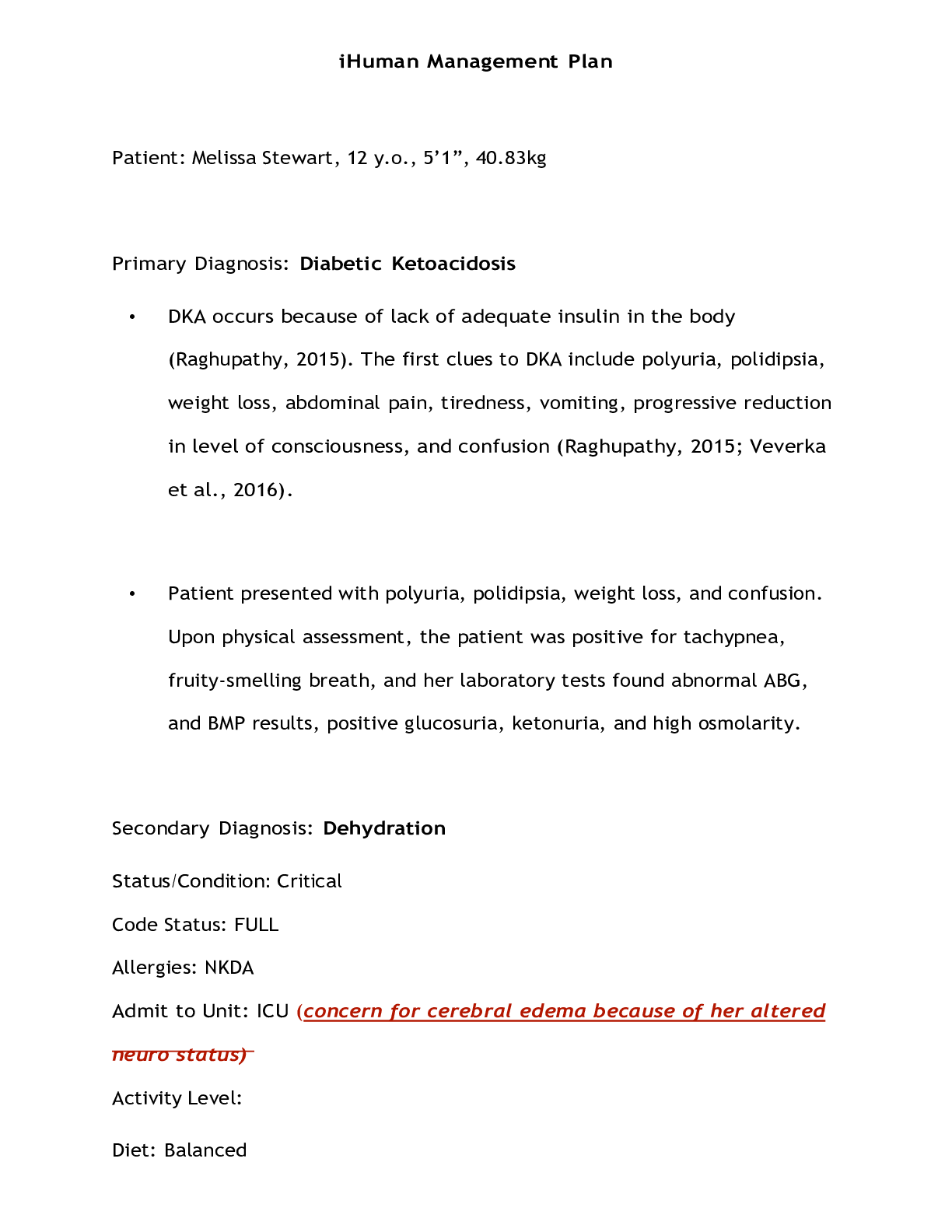


 – Chest Pain Complete Latest Solutions.png)
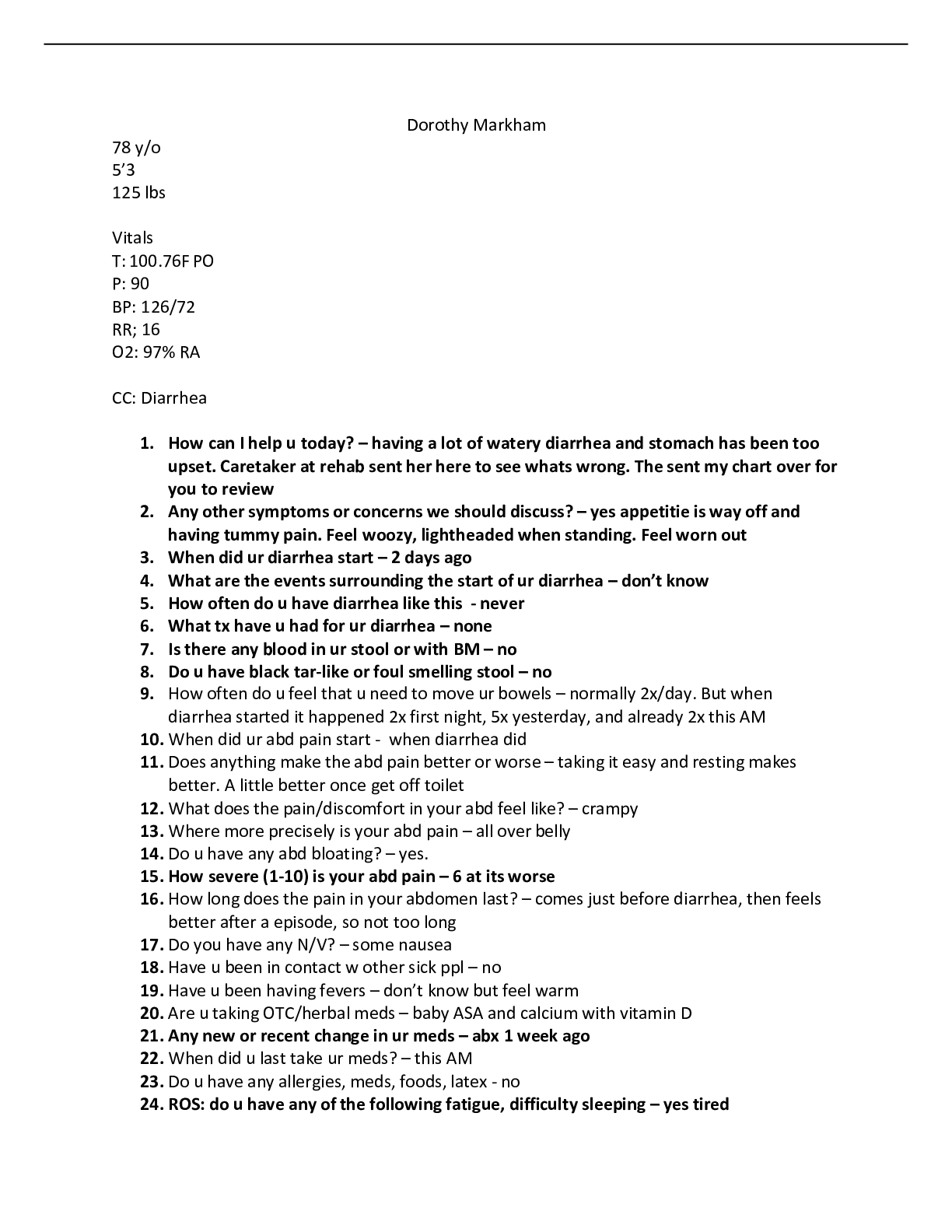
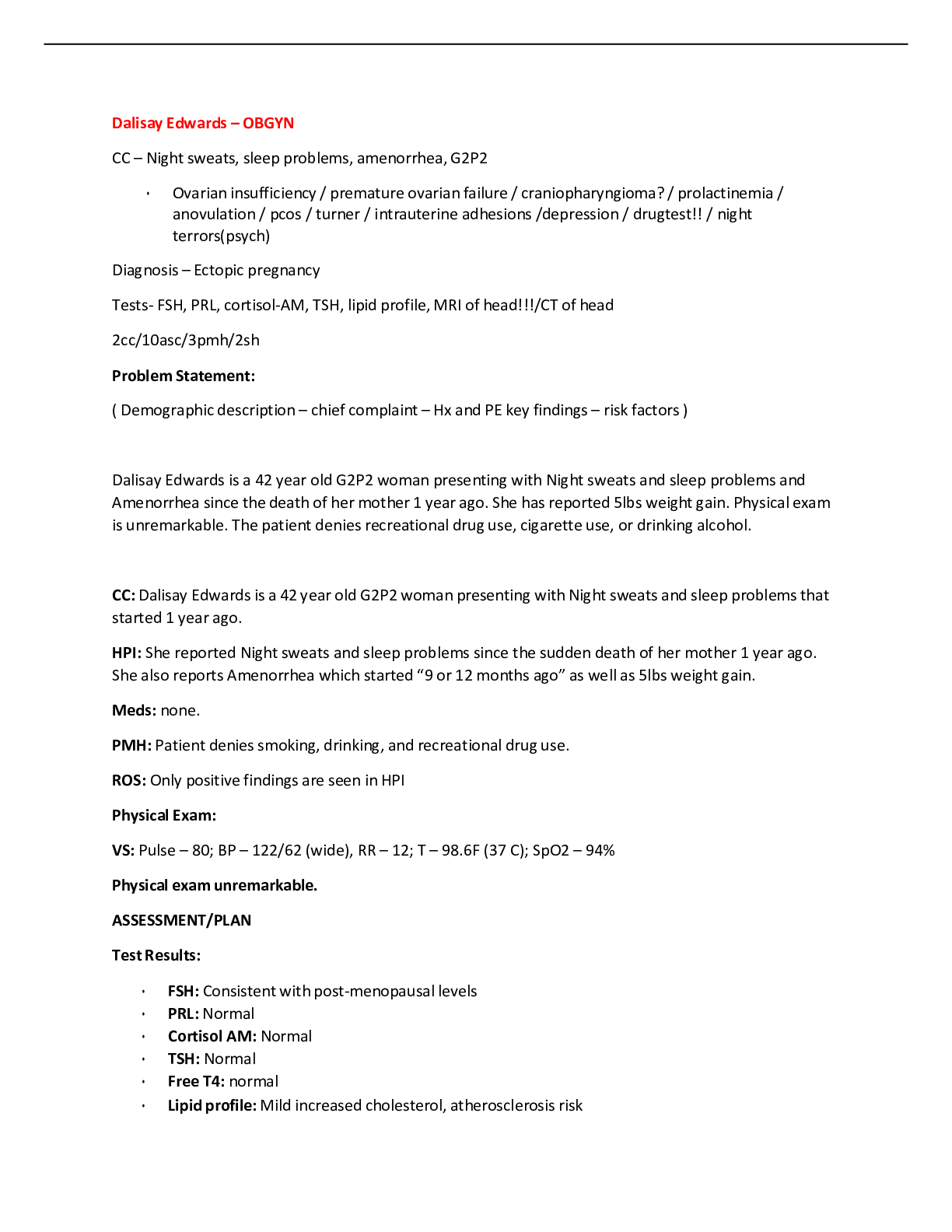

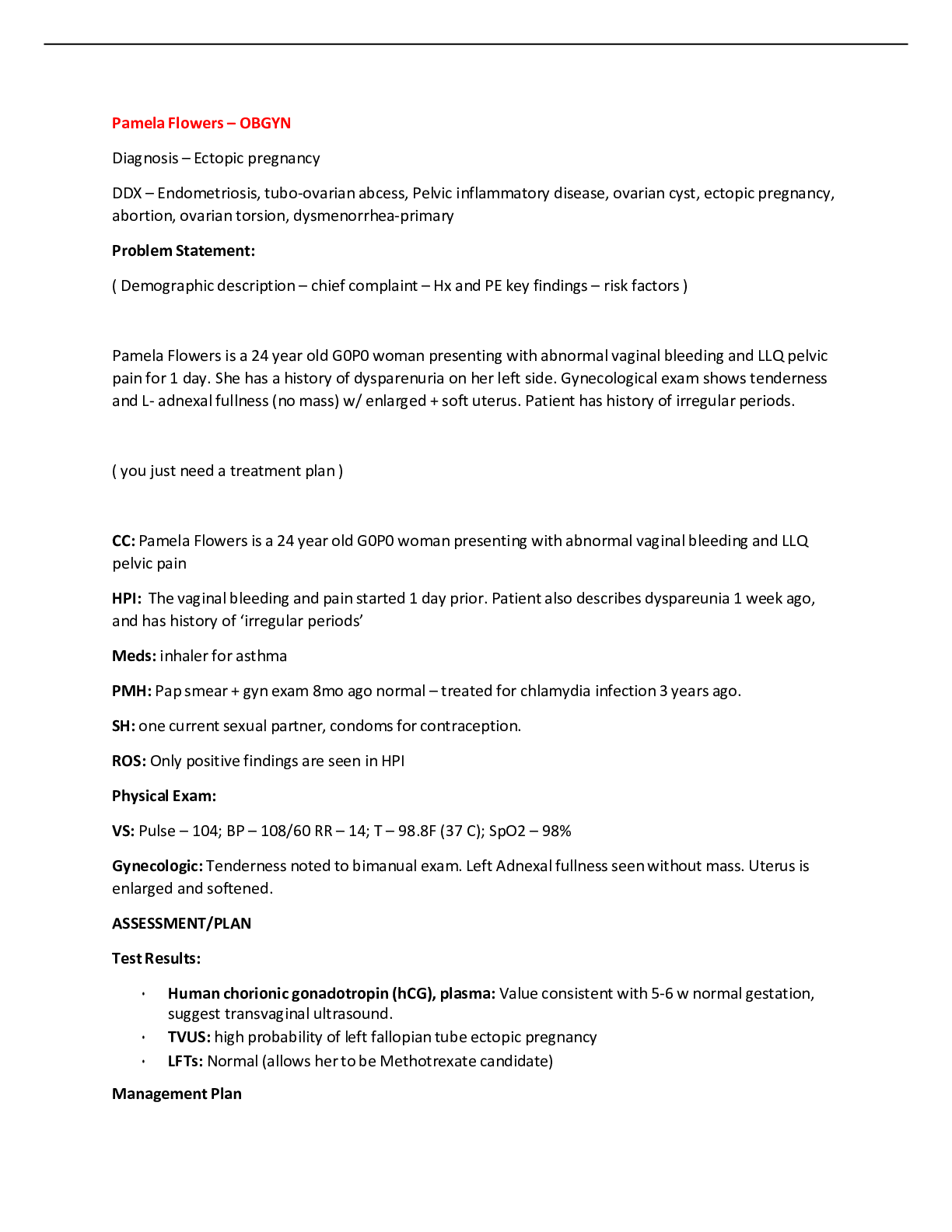


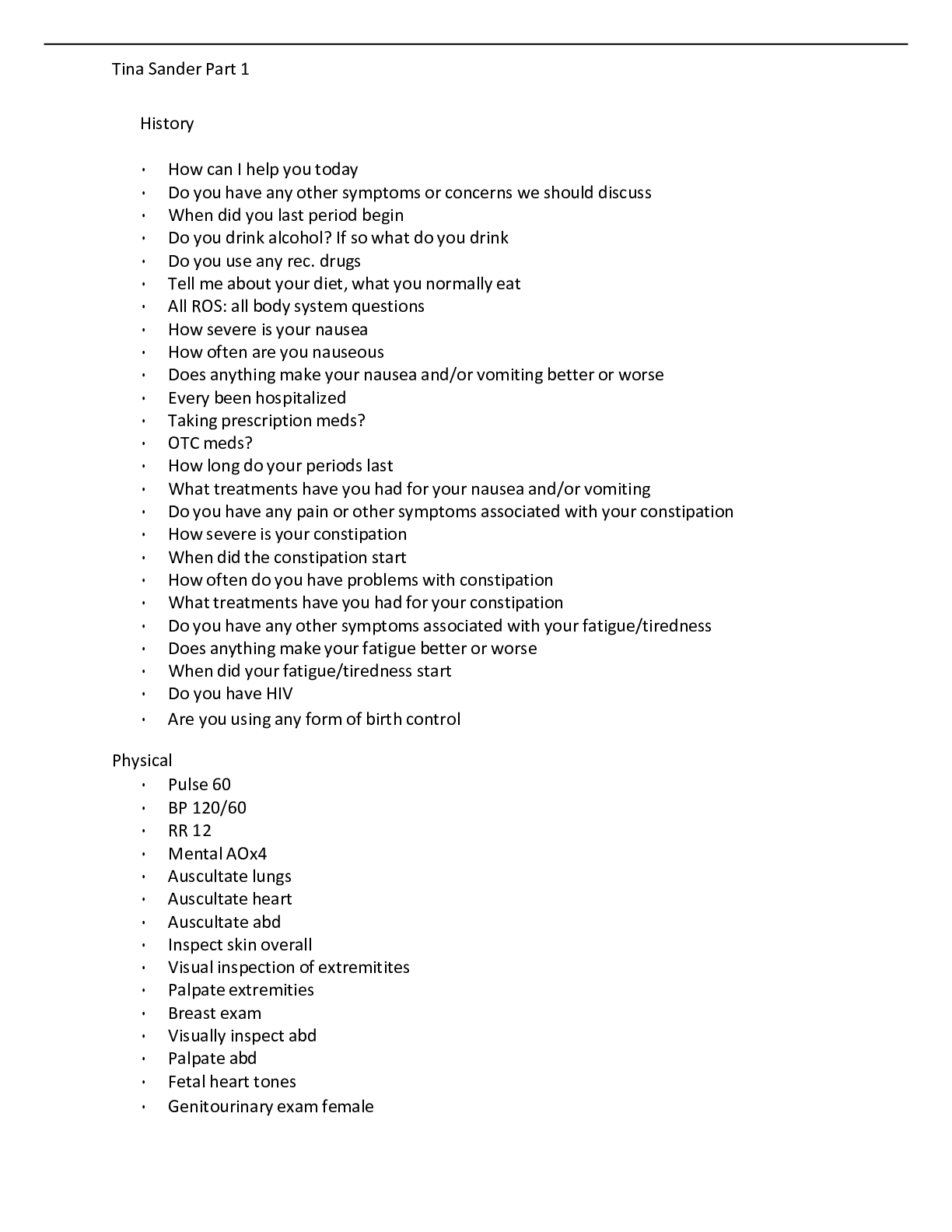

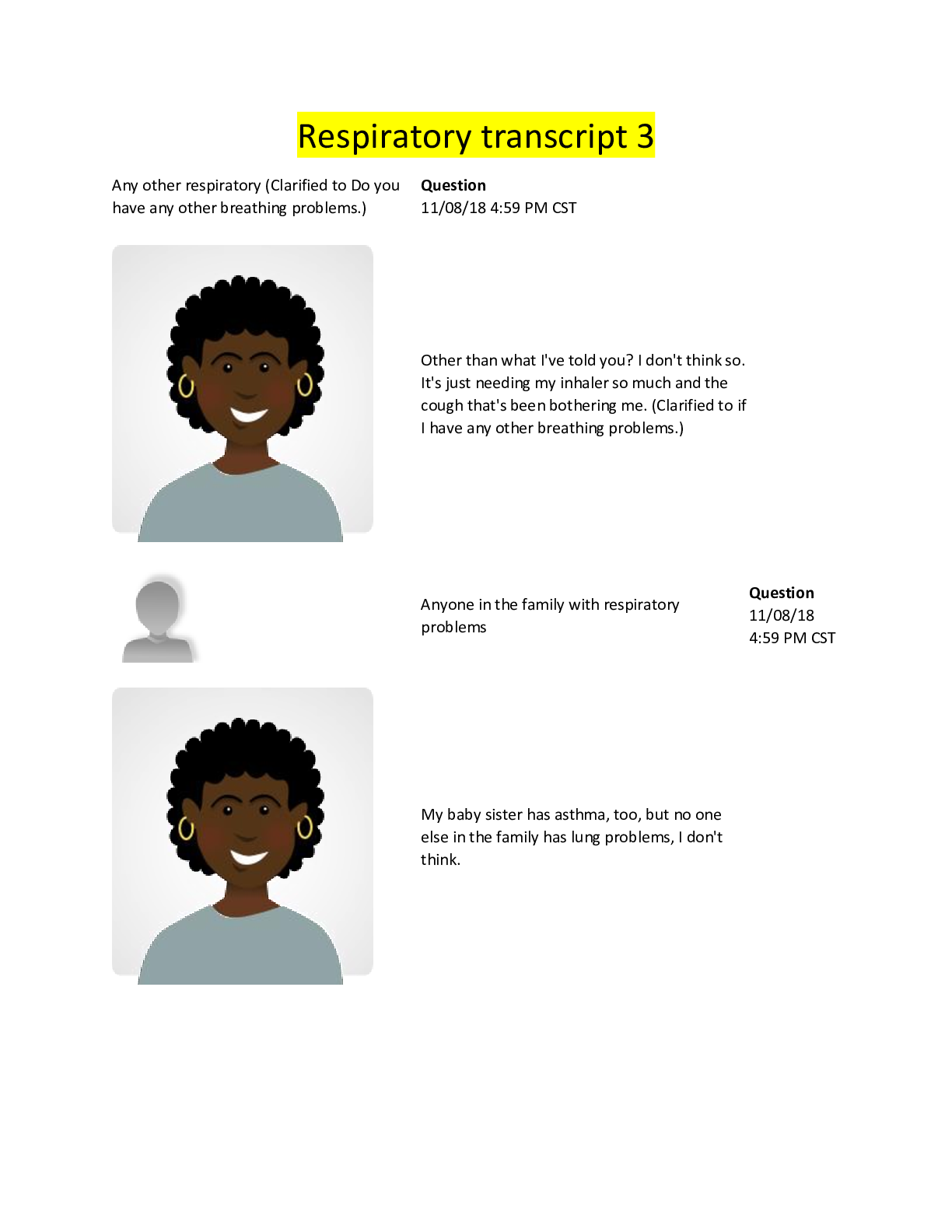
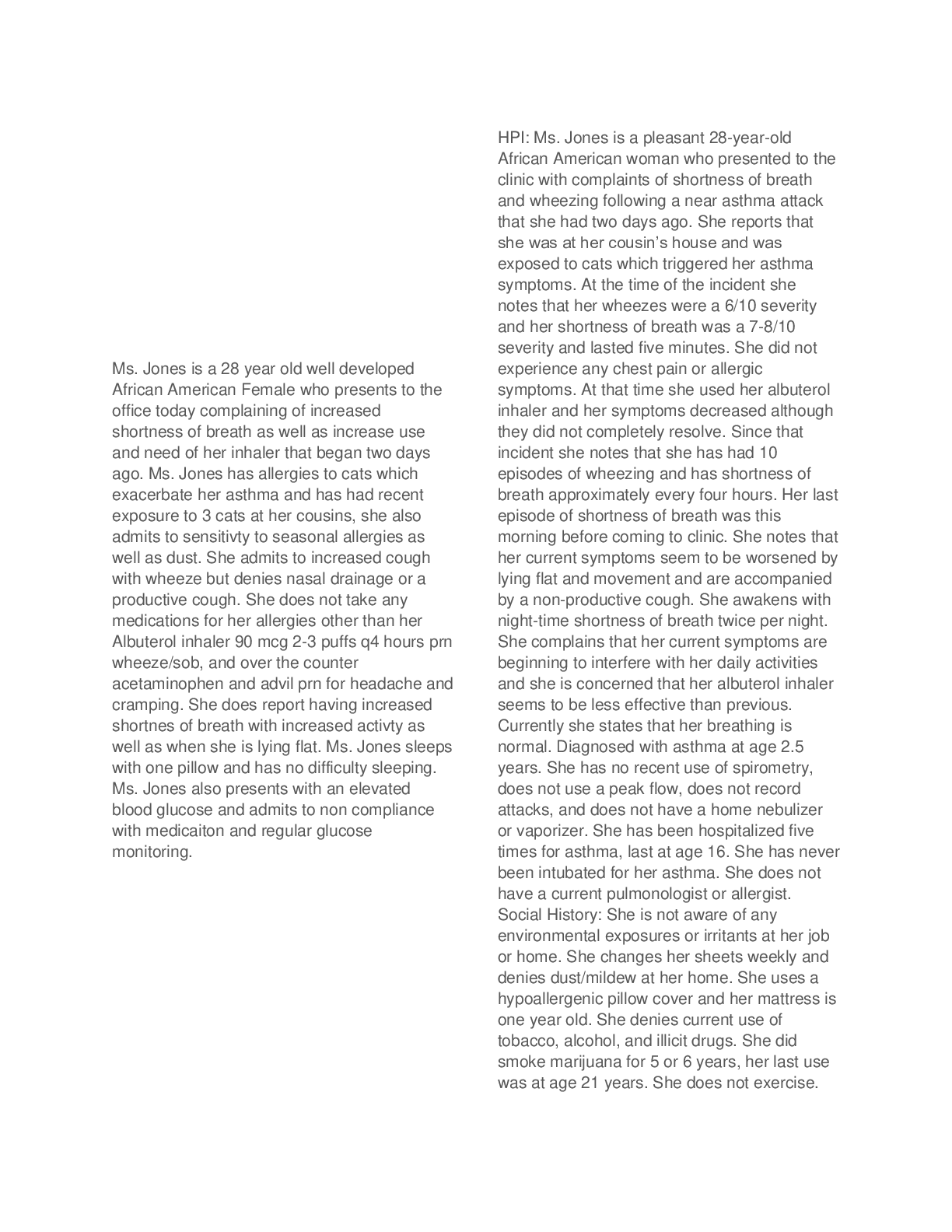
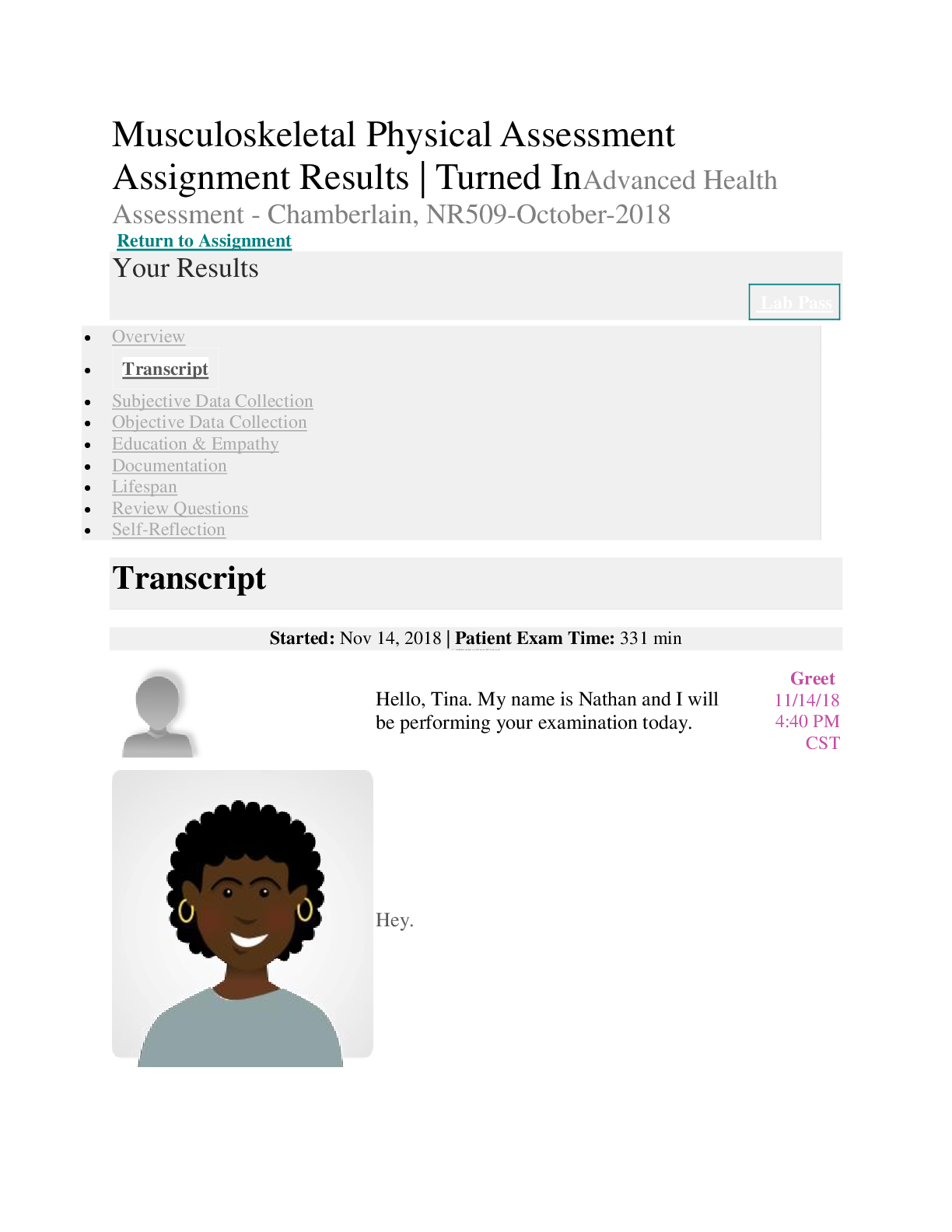
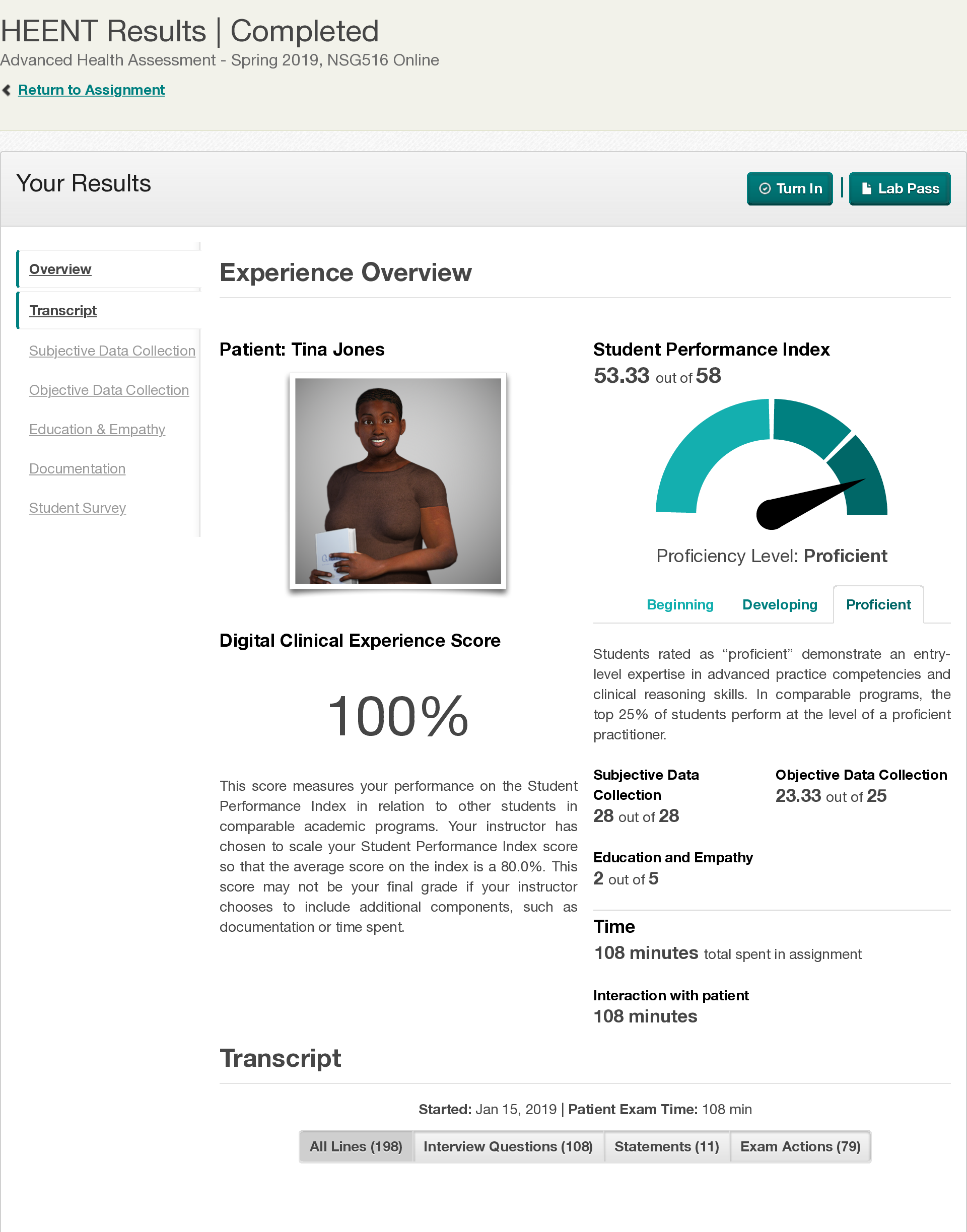

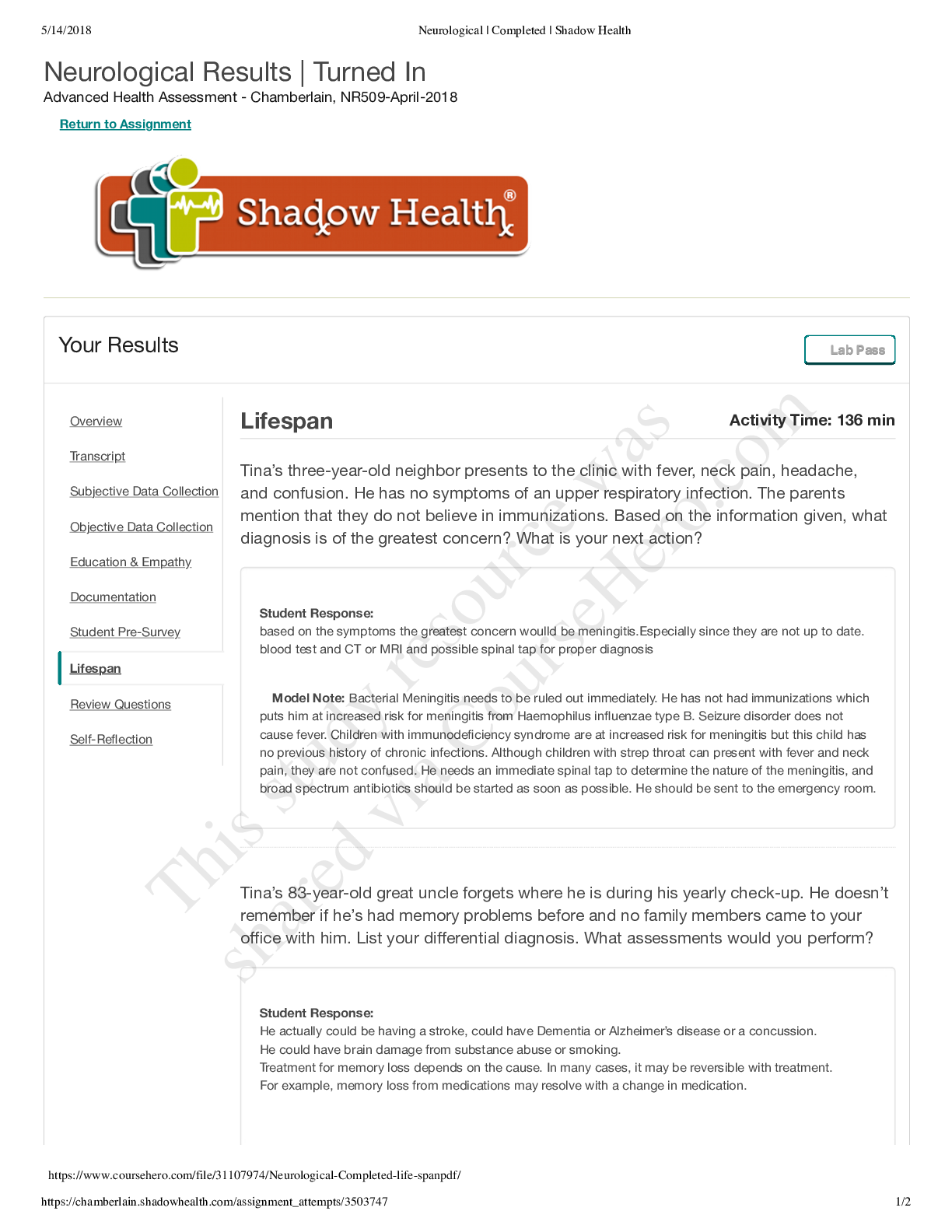
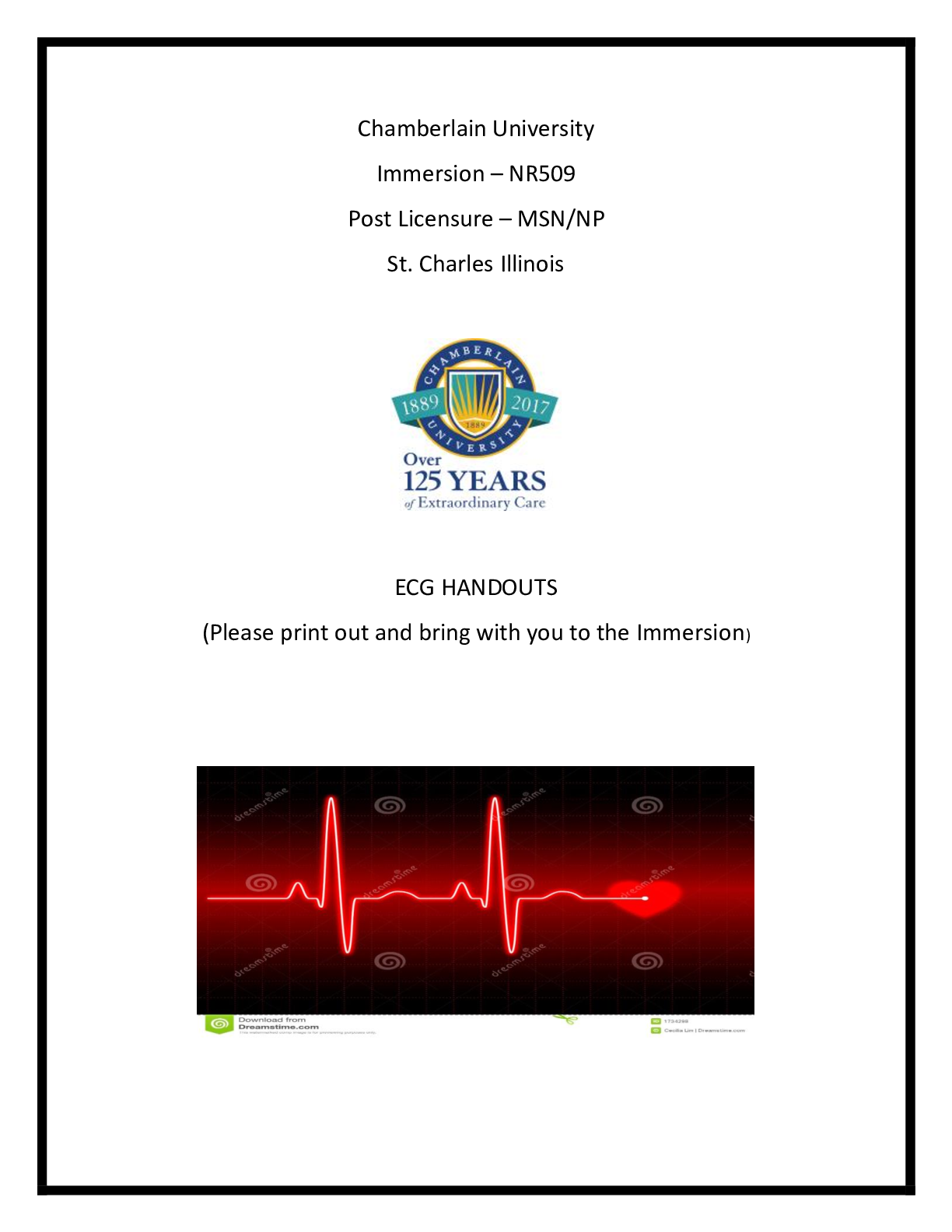
 – Chamberlain College of Nursing.png)
